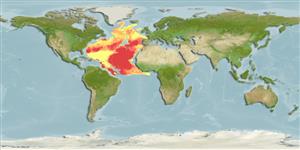>
Saccopharyngiformes (Swallowers and gulpers) >
Monognathidae (Onejaws)
Etymology: Monognathus: Greek, monos = one + Greek, gnathos = jaw (Ref. 45335); boehlkei: Named for the late James E. Böhlke in recognition of his valuable contributions to the study of apodal fishes.
Eponymy: James Erwin Böhlke (1930–1982) and his wife Eugenia Louisa Böhlke née Brandt (1929–2001) were both ichthyologists who worked at the Academy of Natural Sciences of Philadelphia, where he was Curator of Ichthyology (1954–1982). [...] (Ref. 128868), visit book page.
More on authors: Bertelsen & Nielsen.
Environment: milieu / climate zone / depth range / distribution range
Écologie
marin bathypélagique; profondeur 2500 - 5430 m (Ref. 34506). Deep-water
Atlantic Ocean: the holotype was caught near Bermuda and the paratypes southwest of Madeira.
Taille / Poids / Âge
Maturity: Lm ? range ? - ? cm
Max length : 7.0 cm TL mâle / non sexé; (Ref. 34506)
Description synthétique
Clés d'identification | Morphologie | Morphométrie
Rayons mous dorsaux (Total) : 130 - 150; Rayons mous anaux: 110 - 130. M. boehlkei differs from all other species of the genus by the high number of anal fin rays (110-130 vs. 42-88) and by an obtuse angle between rostral fang and frontal profile of skull. It is further distinguished by the following combination of characters: head short, snout blunt, skull length4.2-5.2% TL, rostral fang with dorsal profile slightly concave, anal fin origin below dorsal fin rays number 7-13, pectoral fin 2-3% TL, lower jaw nearly straight, and 6 lateral, subdermal spots of pigmentation (Ref. 34506).
All specimens were taken in closing nets, one between 2500 and 3500 m with a bottom depth of 4563 m and the other specimens between 10-3- m above the bottom with soundings from 2960-5430 m (Ref. 34506).
Life cycle and mating behavior
Maturité | Reproduction | Frai | Œufs | Fécondité | Larves
Bertelsen, E. and J.G. Nielsen, 1987. The deep sea eel family Monognathidae (Pisces, Anguilliformes). Steenstrupia 13(4):141-198. (Ref. 34506)
Statut dans la liste rouge de l'IUCN (Ref. 130435: Version 2024-1)
Menace pour l'homme
Harmless
Utilisations par l'homme
Pêcheries: sans intérêt
Outils
Articles particuliers
Télécharger en XML
Sources Internet
Estimates based on models
Preferred temperature (Ref.
123201): 2.5 - 2.9, mean 2.7 °C (based on 105 cells).
Phylogenetic diversity index (Ref.
82804): PD
50 = 0.5001 [Uniqueness, from 0.5 = low to 2.0 = high].
Bayesian length-weight: a=0.00102 (0.00046 - 0.00225), b=3.06 (2.88 - 3.24), in cm total length, based on all LWR estimates for this body shape (Ref.
93245).
Niveau trophique (Ref.
69278): 3.6 ±0.59 se; based on food items.
Fishing Vulnerability (Ref.
59153): Low vulnerability (10 of 100).
